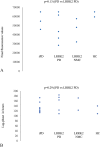α-synuclein RT-QuIC in cerebrospinal fluid of LRRK2-linked Parkinson's disease
- PMID: 31211166
- PMCID: PMC6562027
- DOI: 10.1002/acn3.772
α-synuclein RT-QuIC in cerebrospinal fluid of LRRK2-linked Parkinson's disease
Abstract
Background: Leucine-rich kinase 2 (LRRK2)-linked Parkinson's disease (PD) is clinically indistinguishable from idiopathic PD (IPD). A pleiotropic neuropathology has been recognized but the majority of studies in LRRK2 p.G2019S patients reveal Lewy-type synucleinopathy as its principal histological substrate. To date no in vivo biomarkers of synucleinopathy have been found in LRRK2 mutation carriers.
Objectives: We used real-time quaking-induced conversion (RT-QuIC) technique to assess the presence of alpha-synuclein (a-syn) aggregates in cerebrospinal fluid (CSF) of LRRK2 p.G2019S carriers.
Methods: CSF samples of 51 subjects were analyzed: 15 LRRK2 p.G2019S PD, 10 IPD, 16 LRRK2 p.G2019S nonmanifesting carriers (NMC) and 10 healthy controls. The presence of parkinsonism and prodromal symptoms was assessed in all study subjects.
Results: Forty percent (n = 6) LRRK2-PD, and 18.8% (n = 3) LRRK2-NMC had a positive a-syn RT-QuIC response. RT-QuIC detected IPD with 90% sensitivity and 80% specificity. No clinical differences were detected between LRRK2-PD patients with positive and negative RT-QuIC. A positive RT-QuIC result in LRRK2-NMC occurred in a higher proportion of subjects meeting the Movement Disorder Society research criteria for prodromal PD.
Interpretation: RT-QuIC detects a-syn aggregation in CSF in a significant number of patients with LRRK2-PD, but less frequently than in IPD. A small percentage of LRRK2-NMC tested also positive. If appropriately validated in long-term studies with large number of mutation carriers, and hopefully, postmortem or in vivo confirmation of histopathology, RT-QuIC could contribute to the selection of candidates to receive disease modifying drugs, in particular treatments targeting a-syn deposition.
Conflict of interest statement
Alicia Garrido has no competing interests. Alison Green has no competing interests. Graham Fairfoul has no competing interests. Eduardo Tolosa has no competing interests. Maria Jose Marti has not competing interests.
Figures

Similar articles
-
Brain and Cerebrospinal Fluid α-Synuclein Real-Time Quaking-Induced Conversion Identifies Lewy Body Pathology in LRRK2-PD.Mov Disord. 2023 Feb;38(2):333-338. doi: 10.1002/mds.29284. Epub 2022 Dec 5. Mov Disord. 2023. PMID: 36471633
-
Cerebrospinal fluid biomarkers and clinical features in leucine-rich repeat kinase 2 (LRRK2) mutation carriers.Mov Disord. 2016 Jun;31(6):906-14. doi: 10.1002/mds.26591. Epub 2016 Apr 4. Mov Disord. 2016. PMID: 27041685
-
CSF total and oligomeric α-Synuclein along with TNF-α as risk biomarkers for Parkinson's disease: a study in LRRK2 mutation carriers.Transl Neurodegener. 2020 May 6;9(1):15. doi: 10.1186/s40035-020-00192-4. Transl Neurodegener. 2020. PMID: 32375873 Free PMC article.
-
LRRK2, GBA and their interaction in the regulation of autophagy: implications on therapeutics in Parkinson's disease.Transl Neurodegener. 2022 Jan 31;11(1):5. doi: 10.1186/s40035-022-00281-6. Transl Neurodegener. 2022. PMID: 35101134 Free PMC article. Review.
-
What Have We Learned from Cerebrospinal Fluid Studies about Biomarkers for Detecting LRRK2 Parkinson's Disease Patients and Healthy Subjects with Parkinson's-Associated LRRK2 Mutations?J Parkinsons Dis. 2019;9(3):467-488. doi: 10.3233/JPD-191630. J Parkinsons Dis. 2019. PMID: 31322581 Free PMC article. Review.
Cited by
-
α-Synuclein Seeding Assay Using RT-QuIC.Methods Mol Biol. 2021;2322:3-16. doi: 10.1007/978-1-0716-1495-2_1. Methods Mol Biol. 2021. PMID: 34043187
-
Biofluid Detection of Pathological α-Synuclein in the Prodromal Phase of Synucleinopathies.J Parkinsons Dis. 2024;14(s2):S323-S331. doi: 10.3233/JPD-230429. J Parkinsons Dis. 2024. PMID: 38995801 Free PMC article.
-
Seed amplification and RT-QuIC assays to investigate protein seed structures and strains.Cell Tissue Res. 2023 Apr;392(1):323-335. doi: 10.1007/s00441-022-03595-z. Epub 2022 Mar 8. Cell Tissue Res. 2023. PMID: 35258712 Review.
-
Neuropathology and molecular diagnosis of Synucleinopathies.Mol Neurodegener. 2021 Dec 18;16(1):83. doi: 10.1186/s13024-021-00501-z. Mol Neurodegener. 2021. PMID: 34922583 Free PMC article. Review.
-
α-Synuclein Seed Amplification Assays in the Diagnosis of Synucleinopathies Using Cerebrospinal Fluid-A Systematic Review and Meta-Analysis.Mov Disord Clin Pract. 2023 Mar 15;10(5):737-747. doi: 10.1002/mdc3.13710. eCollection 2023 May. Mov Disord Clin Pract. 2023. PMID: 37205253 Free PMC article. Review.
References
-
- Gaig C, Ezquerra M, Marti MJ, et al. LRRK2 mutations in Spanish patients with Parkinson disease: frequency, clinical features, and incomplete penetrance. Arch Neurol 2006;63:377–382. - PubMed
MeSH terms
Substances
Grants and funding
LinkOut - more resources
Full Text Sources
Medical
Miscellaneous
